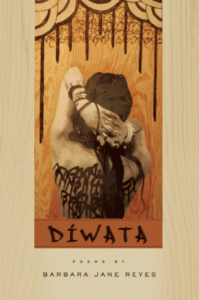
Diwata by Barbara Jane Reyes | BOA Editions 2010 | $16
In Poeta in San Francisco, Barbara Jane Reyes’ previous book, diwata was someone “elders say” had once “walked on earth” before the “the nailed god came” (30). These are the traces and rumors from which the titular Diwata of her latest book is resurrected. Then, like slippery oral art, like slips of the tongue, creation stories about men, women, and diwata—a god or spirit in Philippine mythology—are made up and told again and again. The poems in Diwata draw also on, and retell, Judeo-Christian creation narratives, introduced and enforced in the Philippines by the Spanish colonial regime. These retellings of myths and folk tales become a modality through which ahistory is rendered into history, history itself is investigated, and variations of diwatas, their quarries, and their hunters are revealed as inhabiting multiple narrative, linguistic, and cultural sites.
A globe our size, where migrations, displacements, and diasporas have become fairly common, and networked space-time has become a given for its globalized areas, is increasingly in need of transnational, translingual, transcultural mythologies. Diwata is one such transmission, in English, Spanish, and Tagalog. While most poems in the book take the form of story, it also has songs, couplets, pantoums that pick up the motifs of repetition and variation, creating a sinuous overlapping sonic rhythm.
Diwata inhabits many temporalities: it goes back in time before time and to the pre-colonial time and the colonial time; it stays in once upon a time and also strays in the present. By de-colonizing time from its linear, industrial, western model, it recuperates and liberates mythic, folkloric, and indigenous entities historically demonized and suppressed by the Catholic church and the Spanish colonial administration. The deep time of myth and folklore in Diwata is not static; rather, it is like static, a kind of oracular interference that sharpens the reader’s awareness of acts of wounding as well as acts of resistance performed during Philippines’ colonization, first by Spain and then by the USA.
The cast of characters that perform these acts (and tell the stories) include the first woman, the bamboo (according to Philippine mythology, parent to the first man and the first woman), mermaids/sirens, Diwata, poets, mothers, daughters, old women, young women, aswang, she, I, we. Who tells the story is as important to understanding it as to whom the story is being told. The reader herself might be being addressed, and canalized, into some of the myths being recounted. Is this the reader about to turn into mermaid:
You are the dreaming girl who walks outside herself—
Then, the reader cannot hope to stay at a distance from or out of this text, to have the ‘other’ tell the myths and songs, to not be wounded, to not herself become deity, demon, priest, storyteller.
The two strands of myth—indigenous and Christian—come together in the book when Eve demands of Diwata, Muse, to “Remain with me so that we may keep vigil,” invoking:
a ceaseless, insistent we, the fiercest we, bound only to the knowledge of scars upon my flesh, and the segment of my spine which aches to sprout wings.
Connected to Eve’s un-surrendering are Reyes’ own mythicized alter egos: the first, a “strange deity” taunted by her eldest brother: “¡Bárbara! ¡Que barbaridad!” The second, Saint Barbara, is charged with protecting “us” from harm and she seems to be quite a lady:
Our lady of gunpowder,
our lady of bullets,
our lady of men deep in the earth.
Connected to the shape-shifting Barbaras is the Aswang’s ghoulish battle-cry which climaxes the book:
I am the dark-hued bitch; see how wide my maw, my bloodmoon eyes,
And by daylight, see the tangles and knots of my riverine hair.
I am the bad daughter, the freedom fighter, the shaper of death masks.
I am the snake, I am the crone; I am caretaker of these ancient trees.
I am the winged tik-tik, tik-tik, tik-tik, tik-tik; I am close,
And from under the floorboards, the grunting black pig,
Cool in the dirt, mushrooms between my toes, I wait.
But of course “this story lacks proper symmetry.” Symmetry is an anthropometric concept historically deployed to control and regulate the criminal, the unhealthy, and the mentally deficient; i.e. those falling within the wrong racial, ethnic, or socio-economic category. Diwata, who is all three, must choose asymmetry, and her storyteller too cannot, indeed must not, be symmetrical. Thankfully, Reyes knows this.
2 thoughts on “Review: Barbara Jane Reyes’ DIWATA”